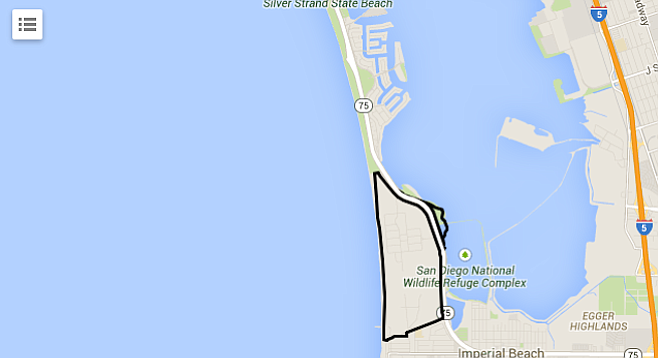 Facebook
Facebook
 X
X
 Instagram
Instagram
 TikTok
TikTok
 Youtube
Youtube

Last month, the Navy’s proposed Coastal Campus on the Silver Strand took another step forward, despite concerns about natural resources, sea rise, and traffic and visual impacts on Coronado and Imperial Beach.
Against a staff recommendation, the California Coastal Commission voted 7-4 to find the project consistent with the state’s Coastal Act. The $700 million campus would replace outdated training facilities for Special Forces with a 1.5 million-square-foot complex spread over about 162 acres.
The work would disturb sensitive dune habitat, where some of the state’s last populations of Nuttall’s lotus and other edge-of-extinction plants have a toehold. A large number of the rare plants face removal. Also occurring on the site is the endangered San Diego fairy shrimp and threatened birds such as snowy plovers, but the Navy included measures to avoid their disruption.
The campus would rest on a low peninsula with a “high coastal vulnerability to sea level rise,” according to a review by the U.S. Environmental Protection Agency. The agency called for a more “robust” plan to address climate change, including its effects on rare species, habitat, and contaminated areas, which were overlooked in the Navy’s draft environmental impact statement. In all, 24 military construction projects would be built over ten years.
Although Coastal Commission staff found the project inconsistent with management of rare plants and habitat, climate change, and scenic resources, the Navy’s draft plan was approved on November 12 at a Federal Consistency Determination in Half Moon Bay. At the hearing, Navy representatives said they will work with city officials. Coronado had submitted comments about traffic and visual impacts at the southern end of the city.
In earlier public workshops, Imperial Beach officials raised similar issues. A recent city-council meeting discussed concerns about Imperial Beach’s developing tourism, water, and environmental quality — though there may also be economic benefits with more Navy personnel using their stores and businesses. The Navy has said the consolidation of training facilities would mean less travel to other locations for its growing Special Forces.
A 2012 survey of rare plants on the Silver Strand included Nuttall’s lotus, the plant most threatened by the project, and other species. The survey by the California Native Plant Society says that Silver Strand State Beach — which borders the project — holds the largest populations of these plants ever found in their surveys.
“If this site was developed, 80 to 90 percent of the plants we surveyed on all beaches would be wiped out,” according to the plant society.
The Navy’s draft report confirms the plant has a holdout at the military site: “Of the few populations of this species left in California, the most significant includes the plants at the training complex.” An environmental impact statement is expected to be finalized by the Navy in spring 2015.


Last month, the Navy’s proposed Coastal Campus on the Silver Strand took another step forward, despite concerns about natural resources, sea rise, and traffic and visual impacts on Coronado and Imperial Beach.
Against a staff recommendation, the California Coastal Commission voted 7-4 to find the project consistent with the state’s Coastal Act. The $700 million campus would replace outdated training facilities for Special Forces with a 1.5 million-square-foot complex spread over about 162 acres.
The work would disturb sensitive dune habitat, where some of the state’s last populations of Nuttall’s lotus and other edge-of-extinction plants have a toehold. A large number of the rare plants face removal. Also occurring on the site is the endangered San Diego fairy shrimp and threatened birds such as snowy plovers, but the Navy included measures to avoid their disruption.
The campus would rest on a low peninsula with a “high coastal vulnerability to sea level rise,” according to a review by the U.S. Environmental Protection Agency. The agency called for a more “robust” plan to address climate change, including its effects on rare species, habitat, and contaminated areas, which were overlooked in the Navy’s draft environmental impact statement. In all, 24 military construction projects would be built over ten years.
Although Coastal Commission staff found the project inconsistent with management of rare plants and habitat, climate change, and scenic resources, the Navy’s draft plan was approved on November 12 at a Federal Consistency Determination in Half Moon Bay. At the hearing, Navy representatives said they will work with city officials. Coronado had submitted comments about traffic and visual impacts at the southern end of the city.
In earlier public workshops, Imperial Beach officials raised similar issues. A recent city-council meeting discussed concerns about Imperial Beach’s developing tourism, water, and environmental quality — though there may also be economic benefits with more Navy personnel using their stores and businesses. The Navy has said the consolidation of training facilities would mean less travel to other locations for its growing Special Forces.
A 2012 survey of rare plants on the Silver Strand included Nuttall’s lotus, the plant most threatened by the project, and other species. The survey by the California Native Plant Society says that Silver Strand State Beach — which borders the project — holds the largest populations of these plants ever found in their surveys.
“If this site was developed, 80 to 90 percent of the plants we surveyed on all beaches would be wiped out,” according to the plant society.
The Navy’s draft report confirms the plant has a holdout at the military site: “Of the few populations of this species left in California, the most significant includes the plants at the training complex.” An environmental impact statement is expected to be finalized by the Navy in spring 2015.
Comments